
Frogger is a 1981 arcade action game developed by Konami and published by Sega. In North America, it was distributed by Sega/Gremlin. The object of the game is to direct five frogs to their homes by dodging traffic on a busy road, then crossing a river by jumping on floating logs and alligators.

Qix is a 1981 puzzle video game developed by husband and wife team Randy and Sandy Pfeiffer and published in arcades by Taito America. Qix is one of a handful of games made by Taito's American division. At the start of each level, the playing field is a large, empty rectangle, containing the Qix, an abstract stick-like entity that performs graceful but unpredictable motions within the confines of the rectangle. The objective is to draw lines that close off parts of the rectangle to fill in a set amount of the playfield.
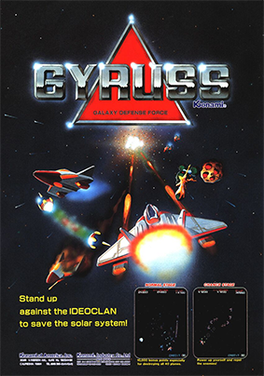
Gyruss is shoot 'em up arcade video game designed by Yoshiki Okamoto and released by Konami in 1983. Gyruss was initially licensed to Centuri in the United States for dedicated machines, before Konami released their own self-distributed conversion kits for the game. Parker Brothers released contemporary ports for home systems. An enhanced version for the Family Computer Disk System was released in 1988, which was released to the North American Nintendo Entertainment System in early 1989.

Tempest is a 1981 arcade game by Atari Inc., designed and programmed by Dave Theurer. It takes place on a three-dimensional surface divided into lanes, sometimes as a closed tube, and viewed from one end. The player controls a claw-shaped "blaster" that sits on the edge of the surface, snapping from segment to segment as a rotary knob is turned, and can fire blaster shots to destroy enemies and obstacles by pressing a button.

Pooyan (プーヤン) is a fixed shooter arcade video game released by Konami in Japan in 1982. It was manufactured in North America by Stern Electronics. The player controls "Mama", a pig whose babies have been kidnapped by a group of wolves.

Pac-Land is a 1984 side-scrolling arcade platform game developed and released by Namco. It was distributed in North America by Bally Midway, and in Europe by Atari Games. Controlling Pac-Man, the player must make it to the end of each stage to return a lost fairy back to its home in Fairyland. Pac-Man will need to avoid obstacles, such as falling logs and water-spewing fire hydrants, alongside his enemies, the Ghost Gang. Eating large flashing Power Pellets will cause the ghosts to turn blue, allowing Pac-Man to eat them for points.
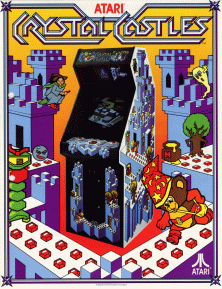
Crystal Castles is an arcade game released by Atari, Inc. in 1983. The player controls Bentley Bear who has to collect gems located throughout trimetric-projected rendered castles while avoiding enemies, some of whom are after the gems as well.

Circus Charlie is an action game originally published in arcades by Konami in 1984. The player controls a circus clown named Charlie in six different circus-themed minigames. It was released for MSX in the same year, followed by ports to the Famicom in 1986 by Soft Pro and the Commodore 64 in 1987.

Metro-Cross is a platform game released in arcades by Namco in 1985. It was ported to the Amstrad CPC, Atari ST, Commodore 64, Family Computer, and ZX Spectrum.

Wizard of Wor is an arcade video game released in 1981 by Midway. Up to two players fight together in a series of monster-infested mazes, clearing each maze by shooting the creatures. The game was ported to the Atari 8-bit family, Commodore 64(programmed by Jeff Bruette), Atari 2600, and Atari 5200 and renamed to The Incredible Wizard for the Bally Astrocade. The original cartridge came with a cash prize offer to the first person to complete the game.
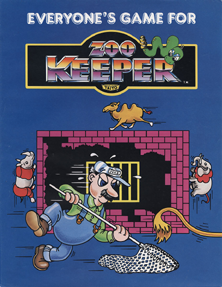
Zoo Keeper is an arcade video game created by Taito America and released in 1983. The player controls Zeke, a zookeeper, attempting to rescue his girlfriend Zelda from a zoo where the animals have escaped from their cages. The majority of the game takes place on a screen where the player builds a wall to keep animals in the zoo—jumping escaped animals to avoid contact. Two different platform game levels are interspersed every few rounds. Zoo Keeper was sold as a conversion kit for Taito's Qix.
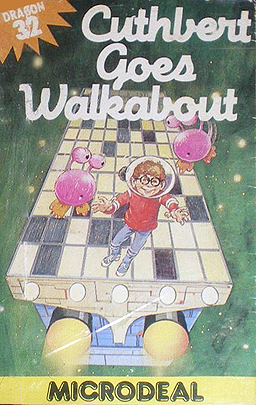
Cuthbert Goes Walkabout is a maze video game written by Steve Bak for the Dragon 32/64 and published by Microdeal in 1983. A TRS-80 Color Computer port was released the same year. Atari 8-bit family and Commodore 64 versions followed in 1984. The game features the character Cuthbert. The game is based on the Konami arcade game Amidar.

Loco-Motion, known as Guttang Gottong in Japan, is an arcade puzzle game developed by Konami in 1982 and released by Sega in Japan. The North American rights were licensed to Centuri. In Loco-Motion, the player builds a path for their unstoppable locomotive by moving tracks which will allow it to pick up passengers.

Shao-lin's Road (少林寺への道), also released in North America as Kicker, is a 1985 beat 'em up video game released by Konami. The game was commercially successful, becoming a chart hit in the arcades. It was ported to several early home computers and has also been featured in classics compilations Konami Arcade Classics for the PlayStation in 1998 and Konami Classics Series: Arcade Hits for the Nintendo DS in 2007.

Circus is a block breaker arcade game released by Exidy in 1977, and distributed by Taito in Japan. The game is a re-themed variant of Atari's Breakout, where the player controls a seesaw and clown in order to pop all the balloons in the level. The game has been copied and released under different names by numerous other companies in both the United States and Japan.
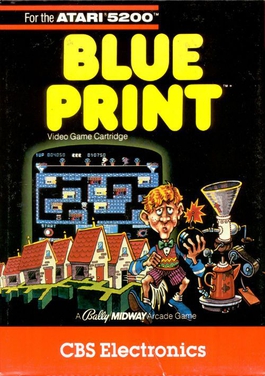
Blue Print is an arcade maze game released in September 1982. It was developed by the Stamper brothers and licensed to Bally Midway. Ports of Blue Print were published by CBS Electronics for the Atari 2600, Atari 5200, and Commodore 64 in 1983.

Pepper II is an arcade video game developed by Exidy and published in 1982. Despite its name, there was no predecessor named Pepper or Pepper I. As in Amidar by Konami and Stern Electronics, the goal is to color the lines on a grid; each rectangle is filled-in after being completely surrounded. Coleco published a port of Pepper II for its ColecoVision home system.
Triple Punch is a horizontally-scrolling grid capture game released in arcades by K.K. International (K.K.I.) in 1982. The goal is to color all of the lines on a grid while avoiding or punching pursuers. It was sold both as a conversion kit and as an upright cabinet.

Kid Grid is a grid capture game which borrows heavily from the 1981 arcade video game Amidar. Written by Arti Haroutunian for Atari 8-bit computers, it was published by Tronix in 1982. A Commodore 64 port from the same programmer was released in 1983. In Kid Grid, the player moves along the horizontal and vertical lines of the playfield, turning the lines from dotted gray to solid blue. If all the lines around a square are completed, it is filled-in. Deadly creatures chase the player.



















